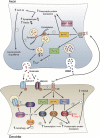Deep brain stimulation: potential for neuroprotection
- PMID: 30656196
- PMCID: PMC6331208
- DOI: 10.1002/acn3.682
Deep brain stimulation: potential for neuroprotection
Abstract
Over the last two decades there has been an exponential rise in the number of patients receiving deep brain stimulation (DBS) to manage debilitating neurological symptoms in conditions such as Parkinson's disease, essential tremor, and dystonia. Novel applications of DBS continue to emerge including treatment of various psychiatric conditions (e.g. obsessive-compulsive disorder, major depression) and cognitive disorders such as Alzheimer's disease. Despite widening therapeutic applications, our understanding of the mechanisms underlying DBS remains limited. In addition to modulation of local and network-wide neuronal activity, growing evidence suggests that DBS may also have important neuroprotective effects in the brain by limiting synaptic dysfunction and neuronal loss in neurodegenerative disorders. In this review, we consider evidence from preclinical and clinical studies of DBS in Parkinson's disease, Alzheimer's disease, and epilepsy that suggest chronic stimulation has the potential to mitigate neuronal loss and disease progression.
Figures

Similar articles
-
Mechanisms of deep brain stimulation.J Neurophysiol. 2016 Jan 1;115(1):19-38. doi: 10.1152/jn.00281.2015. Epub 2015 Oct 28. J Neurophysiol. 2016. PMID: 26510756 Free PMC article. Review.
-
Modifying the progression of Alzheimer's and Parkinson's disease with deep brain stimulation.Neuropharmacology. 2020 Jul;171:107860. doi: 10.1016/j.neuropharm.2019.107860. Epub 2019 Nov 23. Neuropharmacology. 2020. PMID: 31765650 Review.
-
Physical exercise-mediated neuroprotective mechanisms in Parkinson's disease, Alzheimer's disease, and epilepsy.Braz J Med Biol Res. 2024 Nov 25;57:e14094. doi: 10.1590/1414-431X2024e14094. eCollection 2024. Braz J Med Biol Res. 2024. PMID: 39607205 Free PMC article. Review.
-
Surgery insight: Deep brain stimulation for movement disorders.Nat Clin Pract Neurol. 2006 Jun;2(6):310-20. doi: 10.1038/ncpneuro0193. Nat Clin Pract Neurol. 2006. PMID: 16932575 Review.
-
Deep brain stimulation emerging indications.Prog Brain Res. 2011;194:83-95. doi: 10.1016/B978-0-444-53815-4.00015-7. Prog Brain Res. 2011. PMID: 21867796 Review.
Cited by
-
Therapy for Alzheimer's disease: Missing targets and functional markers?Ageing Res Rev. 2021 Jul;68:101318. doi: 10.1016/j.arr.2021.101318. Epub 2021 Mar 9. Ageing Res Rev. 2021. PMID: 33711510 Free PMC article. Review.
-
Deep brain stimulation by blood-brain-barrier-crossing piezoelectric nanoparticles generating current and nitric oxide under focused ultrasound.Nat Biomed Eng. 2023 Feb;7(2):149-163. doi: 10.1038/s41551-022-00965-4. Epub 2022 Dec 1. Nat Biomed Eng. 2023. PMID: 36456857
-
[Design and application of neural electrical stimulation system with time-varying parameters].Sheng Wu Yi Xue Gong Cheng Xue Za Zhi. 2021 Dec 25;38(6):1144-1153. doi: 10.7507/1001-5515.202102028. Sheng Wu Yi Xue Gong Cheng Xue Za Zhi. 2021. PMID: 34970898 Free PMC article. Chinese.
-
Deep-Brain Stimulation for Essential Tremor and Other Tremor Syndromes: A Narrative Review of Current Targets and Clinical Outcomes.Brain Sci. 2020 Dec 1;10(12):925. doi: 10.3390/brainsci10120925. Brain Sci. 2020. PMID: 33271848 Free PMC article. Review.
-
Neuroimaging evaluation of deep brain stimulation in the treatment of representative neurodegenerative and neuropsychiatric disorders.Bioelectron Med. 2021 Mar 30;7(1):4. doi: 10.1186/s42234-021-00065-9. Bioelectron Med. 2021. PMID: 33781350 Free PMC article. Review.
References
-
- Fasano A, Lozano AM. Deep brain stimulation for movement disorders: 2015 and beyond. Curr Opin Neurol 2015;28:423–436. - PubMed
-
- Tierney TS, Sankar T, Lozano AM. Deep brain stimulation emerging indications. Prog Brain Res 2011;194:83–95. - PubMed
-
- Lozano AM, Hutchison WD, Kalia SK. What have we learned about movement disorders from functional neurosurgery? Annu Rev Neurosci 2017;40:453–477. - PubMed
-
- Kalia LV, Lang AE. Parkinson's disease. Lancet 2015;386:896–912. - PubMed
Publication types
MeSH terms
LinkOut - more resources
Full Text Sources
Medical
